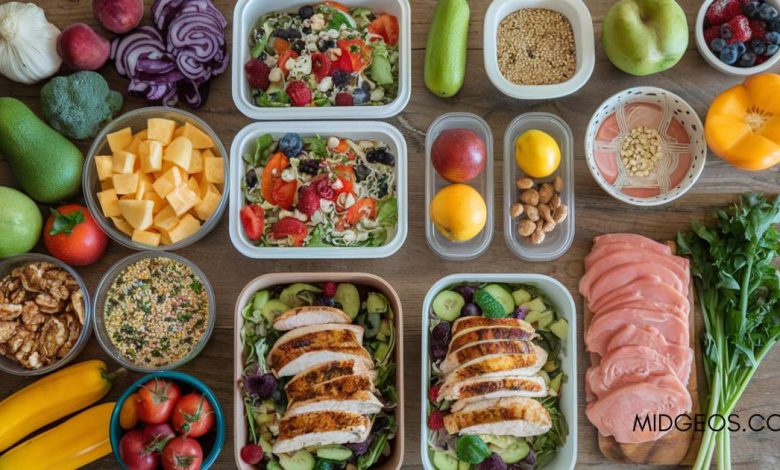Simple Meal Prep for Beginners: Healthy & Easy Recipes for the Week

Meal prepping can be a game-changer for saving time, money, and stress during the week, especially if you’re new to it. If you’re wondering how to get started, don’t worry! With a few simple meal prep techniques, you can prepare delicious and healthy meals without spending hours in the kitchen.
This guide will walk you through meal prep for the week for beginners, focusing on easy and healthy meal prep ideas that are perfect for all skill levels. You’ll discover meal prep recipes that are simple to follow, as well as easy meal prep lunches you can take to work.
Whether you’re trying to eat healthier, stick to a budget, or streamline your weekly routine, meal prepping offers countless benefits.
From tips on planning your meals to creating a grocery list and cooking efficiently, we’ll cover everything you need to know.
See Also: Quick & Easy Breakfast Ideas for a Perfect Morning Start
Plus, we’ll include a variety of healthy and delicious recipes to get you started. By the end, you’ll be ready to conquer the week with confidence and a fridge full of nutritious meals!
Meal Prep for The Week for Beginners
Meal prep is the practice of planning, preparing, and portioning meals in advance for the week ahead. This approach has become a game-changer for those looking to save time, eat healthier, and maintain a consistent diet. Whether you’re a busy professional, a student, or someone looking to simplify your daily routine, meal prep offers a practical solution to managing your meals efficiently.
Why is Meal Prep Beneficial?
- Saves Time: Prepping meals in advance eliminates the daily hassle of deciding what to cook and minimizes cooking time during the week.
- Promotes Healthier Eating: By planning ahead, you can ensure your meals are balanced, nutritious, and aligned with your dietary goals.
- Reduces Stress: Meal prep helps you avoid last-minute decisions and unhealthy takeout options, creating a more organized and stress-free lifestyle.
Common Concerns for Beginners
- Time Commitment: It might seem daunting at first, but with proper planning, meal prep can take just a few hours of your weekend.
- Equipment: You don’t need fancy tools; basic kitchen items like storage containers, a knife, and a cutting board are enough to start.
- Cost: While there may be an initial investment in ingredients and containers, meal prep often saves money by reducing food waste and cutting back on takeout.
With a little preparation and the right mindset, meal prep can become a rewarding habit that simplifies your life while helping you achieve your health and wellness goals.
Getting Started: Simple Meal Prep for Beginners
Meal prep can seem overwhelming at first, but breaking it into simple steps makes it manageable and enjoyable. Here’s how to start with confidence.
2.1. Planning Your Meals for the Week
Why a Meal Prep Plan Matters
Having a plan ensures variety, prevents food boredom, and helps you stick to your dietary goals. It also minimizes food waste and keeps you on track with your budget.
Tips for Creating a Meal Prep Plan
- Plan for Variety: Choose recipes with different proteins, grains, and vegetables to keep meals interesting.
- Portion Control: Decide how many servings you need for each meal to avoid over-prepping or under-prepping.
- Include Snack Options: Prep snacks like cut fruits, veggie sticks, or yogurt for quick, healthy bites.
Creating a Grocery List
- Write down ingredients based on your menu, organizing them by category (produce, pantry, proteins, etc.).
- Check your pantry and fridge first to avoid buying items you already have.
Budget-Friendly Tips
- Shop for seasonal produce and buy in bulk where possible.
- Use affordable staples like rice, beans, and frozen vegetables.
- Look for sales and discounts on proteins or meal prep essentials.
2.2. Essential Tools for Simple Meal Prep
Basic Equipment
- Storage Containers: Opt for a mix of sizes, and consider glass containers for reheating food safely.
- Knives and Cutting Boards: Invest in a quality knife and designate separate boards for meat and veggies.
- Measuring Cups and Spoons: Useful for portioning ingredients accurately.
Storage Tips
- Glass vs. Plastic: Glass containers are more durable and better for reheating, while plastic options are lighter and budget-friendly.
- Freezer-Friendly Options: Choose containers that seal tightly to prevent freezer burn.
- Labeling: Use labels to note the contents and dates to keep track of freshness.
By starting small and using the right tools, beginners can simplify meal prep and set the foundation for a healthy, organized lifestyle.
See Also: 27 Quick & Easy Family Dinner Recipes You’ll Love
Healthy Meal Prep Ideas for the Week
Prepping healthy meals doesn’t have to be complicated. By focusing on balanced components and portion control, you can create delicious and nutritious meals for the entire week.
3.1. Balanced Meal Components
A well-rounded meal includes proteins, carbohydrates, and vegetables. Here’s how to mix and match for variety and flavor:
Proteins
- Chicken: Grilled, baked, or shredded for salads, wraps, or bowls.
- Tofu or Tempeh: Marinate and bake for a plant-based option.
- Beans and Lentils: High in fiber and perfect for soups, stews, or bowls.
- Fish: Salmon or tilapia for omega-3s; cook in batches and refrigerate.
Carbs
- Quinoa or Brown Rice: Great for bowls and stir-fries, packed with nutrients.
- Sweet Potatoes: Roast in cubes or mash for an easy side.
- Whole-Grain Pasta: Use for salads or mix with veggies and proteins.
Veggies
- Roasted Vegetables: Broccoli, zucchini, carrots, or cauliflower.
- Steamed Options: Green beans, asparagus, or peas for a light side dish.
- Raw Veggies for Salads: Spinach, kale, cucumbers, and cherry tomatoes.
Healthy Snacks
- Hummus with veggie sticks or whole-grain crackers.
- Hard-boiled eggs for a quick protein boost.
- Pre-portioned nuts or trail mix.
3.2. Portion Control Tips
Why Portion Control Matters
Proper portion sizes help you meet dietary goals, avoid overeating, and ensure balanced meals throughout the day.
Using Portion Sizes for Balance
- Protein: Aim for a palm-sized portion (about 4-6 ounces).
- Carbs: One fist-sized portion (about 1 cup cooked).
- Veggies: Two fist-sized portions for maximum nutrients and satiety.
How to Pack Balanced Meals
- Use meal prep containers with dividers to separate proteins, carbs, and veggies.
- Avoid overfilling; stick to your portion guidelines.
- Label each container with its contents and day of the week for easy organization.
By combining these balanced components and managing portions, you can create a week’s worth of satisfying, healthy meals that support your goals and save time.
Easy Meal Prep Recipes for Beginners
Jumping into meal prep is easier with simple, delicious recipes. Here are beginner-friendly ideas for every meal, including snacks and sides, to keep you fueled all week.
4.1. Breakfast Recipes
Kickstart your day with nutritious, make-ahead options that require minimal effort:
Overnight Oats with Fruit and Nuts
- Combine oats, milk (or a dairy-free alternative), and a sweetener like honey in a jar.
- Top with fruits like berries, bananas, or apples and a sprinkle of nuts or seeds.
- Refrigerate overnight for a grab-and-go breakfast.
Egg Muffins Packed with Veggies
- Whisk eggs with chopped veggies like bell peppers, spinach, and onions.
- Pour the mixture into a muffin tin and bake at 375°F for 15-20 minutes.
- Store in the fridge and reheat as needed.
4.2. Lunch Recipes
Stay energized throughout the day with these satisfying, balanced lunches:
Quinoa and Roasted Veggie Bowls
- Roast vegetables like zucchini, broccoli, and carrots.
- Layer cooked quinoa, roasted veggies, and a protein like grilled chicken or beans in a container.
- Drizzle with your favorite dressing or sauce before eating.
Grilled Chicken Wraps with Hummus and Greens
- Spread hummus on a whole-grain tortilla.
- Add sliced grilled chicken, mixed greens, and shredded carrots.
- Roll tightly and pack for an easy, portable lunch.
4.3. Dinner Recipes
Simple, flavorful dinner options that come together quickly:
Sheet Pan Meals
- Arrange chicken breasts, chopped sweet potatoes, and vegetables like Brussels sprouts on a baking sheet.
- Season with olive oil, garlic, and herbs.
- Bake at 400°F for 25-30 minutes.
Stir-Fry with Tofu, Veggies, and Brown Rice
- Sauté tofu cubes in a skillet until crispy.
- Add a mix of veggies like snap peas, bell peppers, and mushrooms.
- Stir in soy sauce or a homemade stir-fry sauce and serve over brown rice.
4.4. Snacks and Sides
Keep hunger at bay with these quick and healthy options:
Pre-Cut Fruits and Veggies with Dips
- Slice cucumbers, carrots, and celery. Pair with hummus or Greek yogurt-based ranch dip.
- Prep fruit like melons, pineapple, or grapes into single-serving portions.
Energy Bites with Oats, Peanut Butter, and Chocolate Chips
- Mix rolled oats, peanut butter, honey, and mini chocolate chips.
- Roll into bite-sized balls and refrigerate.
- Perfect for a quick energy boost between meals.
These easy meal prep recipes will save you time, ensure balanced nutrition, and keep your taste buds happy all week!
Easy Meal Prep Lunches to Take to Work
Preparing lunches to take to work doesn’t have to be complicated. With a bit of planning, you can enjoy fresh, delicious, and nutritious meals on the go.
5.1. Quick and Portable Lunch Ideas
Mason Jar Salads with Layered Ingredients
- Layer ingredients in a mason jar for freshness: start with the dressing at the bottom, followed by hearty items like chickpeas or quinoa, and finish with leafy greens on top.
- Examples: Greek salad (cucumber, tomatoes, feta, olives) or Southwest salad (black beans, corn, salsa).
Grain Bowls with Chicken, Veggies, and Tahini Dressing
- Use a base like brown rice, quinoa, or farro.
- Add grilled chicken or a vegetarian protein, roasted vegetables, and drizzle with tahini or a lemon vinaigrette.
- Pack in a container for a balanced, ready-to-eat lunch.
5.2. Tips for Keeping Lunch Fresh
Using Ice Packs and Insulated Bags
- Store your lunch in an insulated bag with ice packs to maintain freshness.
- Ideal for meals with perishable ingredients like yogurt-based dressings or dairy.
Packing Dressings and Sauces Separately
- Keep dressings or sauces in small, leak-proof containers. Add them right before eating to avoid soggy salads or bowls.
- Consider reusable silicone containers for an eco-friendly option.
By incorporating these ideas and tips, you’ll have easy meal prep lunches that are flavorful, fresh, and convenient for busy workdays!
Time-Saving Meal Prep Tips
Efficient meal prep can save you hours in the kitchen while keeping your meals fresh and delicious throughout the week.
Batch Cooking: Prepare Multiple Portions at Once
- Cook large portions of staples like rice, quinoa, or roasted vegetables.
- Use versatile proteins (e.g., grilled chicken or tofu) that can be seasoned differently for various meals.
- Divide food into individual portions for easy grab-and-go options.
Utilizing Slow Cookers or Instant Pots for Efficiency
- Slow cookers and Instant Pots are ideal for making soups, stews, and casseroles in bulk.
- Set them up in the morning and have meals ready by evening without constant supervision.
- Examples: Chili, pulled chicken, or vegetable curry.
Prepping Ingredients Ahead of Time
- Wash and chop vegetables at the start of the week for salads, stir-fries, or snacks.
- Portion out dry ingredients for recipes like overnight oats or energy bites.
- Freeze pre-cut fruits for smoothies to save time in the mornings.
Overcoming Common Meal Prep Challenges
Meal prep comes with its share of hurdles, but with a little planning, you can overcome them and stay consistent.
Avoiding Food Fatigue: Rotate Recipes Weekly
- Alternate between different cuisines and flavor profiles (e.g., Asian stir-fries, Mediterranean grain bowls).
- Experiment with sauces, spices, and marinades to add variety without overhauling your prep routine.
Managing Limited Fridge/Freezer Space
- Use stackable containers to maximize storage space.
- Opt for compact, freezer-safe bags for soups or sauces.
- Label meals with names and dates to keep track of what to eat first.
Tips for Staying Consistent as a Beginner
- Start small: focus on prepping for 2–3 days at a time to avoid overwhelm.
- Set aside a dedicated time for meal prep, such as Sunday afternoons.
- Celebrate small wins, like successfully prepping lunches for the week, to build momentum.
By implementing these strategies, you’ll make meal prep manageable, time-efficient, and enjoyable, no matter your skill level!
Wrapping Up Your Meal Prep Journey,
Meal prep for the week doesn’t have to be complicated, especially for beginners. By starting with simple meal prep strategies, you can save time, stay organized, and enjoy healthier meals every day. Healthy meal prep ideas and easy meal prep recipes make it possible to enjoy delicious meals without the hassle of daily cooking.
If you’re packing lunches for work, consider prepping balanced and portable meals like grain bowls, wraps, or salads in advance. These easy meal prep lunches will keep you fueled and energized throughout the day.
Remember, meal prepping is all about consistency and personalization. Start small, experiment with new recipes, and adjust your routine as you discover what works best for you. With a little planning and effort, meal prep can become a rewarding habit that supports your lifestyle and goals. Here’s to a productive and delicious week ahead!




